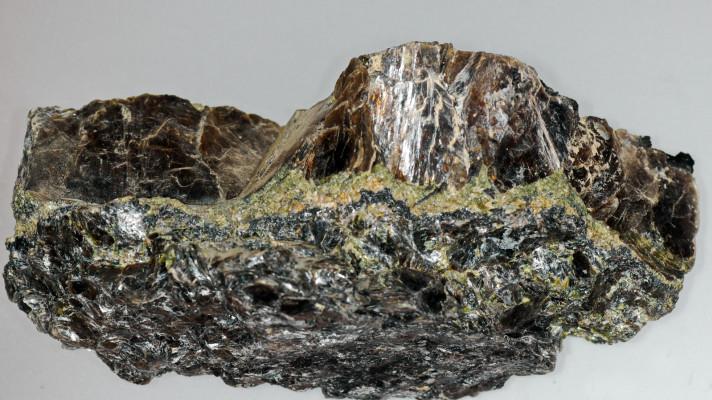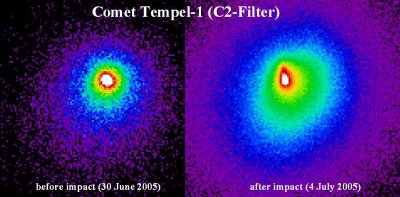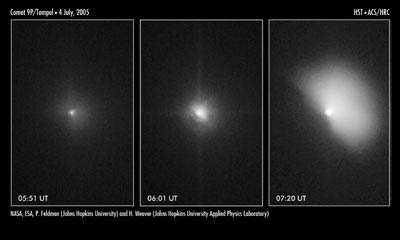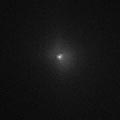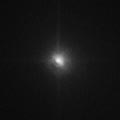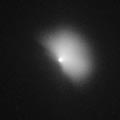Snímky z dopadu sondy Deep impact na kometu Tempel 9P
Dust and gas from Comet 9P/Tempel 1 seen by ESA OGS
|
5 July 2005
Dust and gas are seen in these images of Comet 9P/Tempel 1, as observed with the 1-metre ESA Optical Ground Station (OGS) telescope, located at the Observatorio del Teide on Tenerife, Canary Islands.
Two different filters have been used in different visible light observations to study different aspects of the comet's nature. Red 'broadband' filters allowed the detection of dust, while blue 'narrowband' filters, filtering only carbon gaseous compounds, allow the observations to concentrate mainly on the gas emissions of the comet.
The first set of images (above) here were taken with a broadband red filter, four days before and about 15 hours after the impact respectively. The images were exposed for 10 minutes and show the dust coma of the comet. The dust brightness has increased by 50 percent.
A strong jet has recently appeared as a direct result of the impact, pointing north-north-east. The overall coma is very asymmetric in appearance. All structures must have been created by the outburst triggered by the impact.
|
The second set of images of Tempel 1 from the OGS telescope use a narrowband filter (C2 emission band). They show the coma gas mixed with smaller-sized dust particles than observed in the broadband red filtered image.
The observations were taken two days before and about 16 hours after the impact respectively. Also here the coma brightness has increased by 50 percent. Again the same strong jet is visible.
|
In the third set of images, Tempel 1 is seen about 16 hours after the impact. The two images show the refection of blue (BC filter) and red (RC filter) light from the dust cloud surrounding the comet nucleus.
These reflections show different dust particle sizes, with blue particles being smaller than red particles. It is clear that the jet structure of the smaller dust particles points towards the north (BC image), whereas the jet composed of larger dust particles (RC image) is rotated by about 45 degrees towards the north-east.
This means that the direction in which the dust particles were ejected from the comet nucleus after impact seems to depend on the particle size.
These images introduce ESA’s OGS telescope to the network of Earth-based observatories already taking part in the one of world’s largest astronomical observation campaigns - looking at results of the 4 July comet impact event.
For more information:
Rita Schulz, Principal Investigator, OGS Tempel 1 observations, ESA-ESTEC (The Netherlands)
E-mail: rita.schulz @ esa.int
Hubble captures Deep Impact collision with comet
|
4 July 2005
The NASA/ESA Hubble Space Telescope captured the dramatic effects of the collision early on 4 July between the Deep Impact impactor spacecraft and Comet 9P/Tempel 1.
| |||
| Minutes before impact |
In the middle image, captured 15 minutes after the collision, Tempel 1 appears four times brighter than in the pre-impact photograph.
Astronomers noticed that the inner cloud of dust and gas surrounding the comet's nucleus increased by about 200 kilometres in size.
|
|||
| 15 minutes after impact |
Hubble continued to monitor the comet, snapping another image (at right) 62 minutes after the encounter. In this photograph, the gas and dust ejected during the impact are expanding outward in the shape of a fan.
| |||
| One hour after impact |
The potato-shaped comet is 14 kilometres wide and 4 kilometres long. Tempel 1's nucleus is too small even for the Hubble telescope to resolve.
The visible-light images were taken by the high-resolution camera on Advanced Camera for Surveys instrument. The Hubble Space Telescope is a project of international co-operation between ESA and NASA.
For more information:
Lars Lindberg Christensen
Hubble ESA Information Centre, Garching, Germany
Tel: 49 89 3200 6306
Mobile: 49 173 3872 621
E-mail: lars @ eso.org
P. Feldman
Johns Hopkins University, Baltimore, USA
Tel: 1 410 516 7339
E-mail: pdf @ pha.jhu.edu
Hal Weaver
Johns Hopkins University/Applied Physics Lab, Laurel, USA
Tel: 1 443 778 8078
E-mail: hal.weaver @ jhuapl.edu
Ray Villard
Space Telescope Science Institute, Baltimore, USA
Tel: 1 410 338 4514
E-mail: villard @ tsci.edu
ZDROJ: European Space Agency
